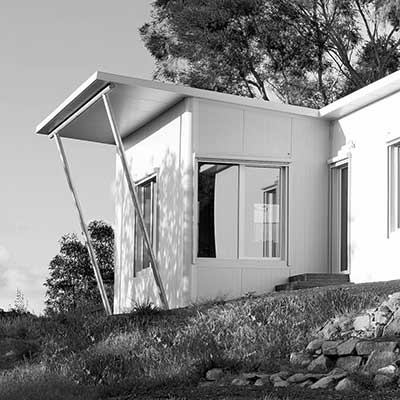A feature article about our founding director, Fiona McKenzie, which partly explains her training, expertise and passion for rigorous and creative thinking.
This article was originally presented in the February 2018 issue of the Law Institute Journal of Victoria.
Building for the future

By Karin Derkley
01 Feb 2018
The rigorous discipline associated with law has been the perfect foundation for designing a failsafe building system.
Barrister Fiona McKenzie is not one for sitting around watching TV after work. Instead the administrative law specialist has been using her spare time over the past couple of years boning up on physics and engineering and poring over spreadsheets to devise sustainable building systems and design award winning furniture.
“I’ve always been interested in design and artistic expression as well as the law,” she says. “I’ve never been just a bookish person or just a creative person – I like having a balance between those two sides of me.”
Helping out family and friends with their renovation projects started as a way of “feeding that other part of my brain,” she says. But then the lawyer part of her brain became intrigued by how to make buildings work better.
“I became very interested in the engineering aspect of how buildings perform and affect the comfort of their occupants,” she says. “I put on my legal research hat to interrogate these things.”
That led her to what she says is the best building standard in the world, the International Passive House Building Standard, which uses physics based engineering to create buildings that reduce energy use by up to 90 per cent.
Evenings and weekends were spent reviving her high school maths and physics to calculate exactly how a building can be designed for complete control of the indoor environment. “It is about designing a thermally sealed building envelope that ensures there are no air leaks, while also providing fresh filtered air all year round.”
That involves designing carefully designed joins, double or even triple glazed windows depending on the local climate and orientation, and high levels of insulation.
“The idea is to create a building that is completely comfortable for its occupants and that is also beautiful,” she says. “Things have got to work practically but they also need to be well designed and look and feel good.”
Ms McKenzie built her first prototype Superpod® passive house in Cape Paterson in 2015, which was recognised with a Good Design Award. She decided it was so important and useful she has refined the system to offer to others. “Once I got the building envelope right, I wanted to look at a more holistic offering and offer different looks.”
That part has been a challenge. The building industry is resistant to new ways of building, she says. So she is relying on commercial projects in the educational space, other markets such as ecotourism operators and healthcare providers, and even owner builders to recognise the benefits of the system.
The Cape Paterson house is available for holiday rentals so people can try out the system for themselves, and she has recently started the process of building a mini-hotel near the Museum of New and Old Art in Hobart that will not only showcase the podhouses, but will also be fitted out with the PodMarket range of furniture designed by her fellow director and furniture designer Harry Strouzas.
The furniture range is designed along similar principles of sustainable design, Ms McKenzie says: “functional, and a minimalist use of beautiful materials”. PodMarket includes a range aimed specifically at barristers and solicitors – including storage, seating and tables. One of the tables has been nominated for the German Design Award 2018.
“In the same way we approached the issue of how do we solve designing buildings better, we looked at how we could resolve furnishing rooms better.”
Her training as a lawyer has come in handy for drawing up contracts and applying for patents, Ms McKenzie says. But the rigorous discipline associated with the law has also been the perfect foundation for helping her design a failsafe building system that appeals aesthetically to potential buyers.
“It’s a lot like when you have to present a brief to a judge,” she laughs. “You have to hold their attention and you know it’s going to be picked apart. You can’t have any loose threads.”
To see the article as it appears in the Law Institute Journal please follow this link:
https://www.liv.asn.au/Staying-Informed/LIJ/LIJ/Jan-Feb-2018/Building-for-the-future





